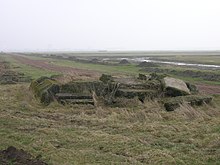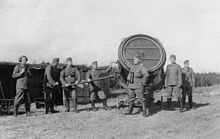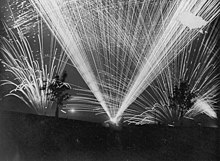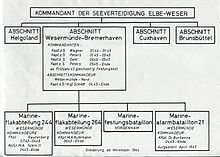Flak battery Tabar
The Flakbatterie Tabar was a bunkered position of the naval flak in the south of Wesermünde during World War II . The name refers to the Tabar Islands . A reference to German colonies in the Pacific Ocean had also been chosen for the Marine Flak Department 244 in Weddewarden with Upolu .
history
The heavy flak position Tabar at the mouth of the Lune was occupied on August 24, 1939. The soldiers, who had moved from all over the German Reich , were given field-gray uniforms with epaulettes from the navy and carried two crossed anchors and the IV. The marines were brought to Wesermünde in trucks and distributed to the heavy flak positions there. When the first reached "Tabar", the position was still like a large construction site with dug trenches, junk, rubble and sodden paths. The bunkers, which had neither electricity nor water, were reached via laid planks. Eight anti-aircraft bunkers stood between wooden shacks; remains of two others further south can still be seen today.
everyday life
On the day Britain declared war (September 3, 1939), the position with its three 8.8 cm guns was ready for action. Two camouflage bunkers, black roofs and red outer walls as well as the layout of gardens, fruit trees and paths simulated a residential area to reconnaissance aircraft. When a water pipe was laid in the winter of 1940, the toilets in the bunkers could be used. Monthly comradeship evenings and events for strength through joy in the "Tabarina" should help against boredom . The soldiers wrote poems and lyrics, founded a band and organized colorful evenings . Three wrote a war diary .
Calls
Reinforced against low-flying aircraft with a headlight unit and a carriage , the anti-aircraft battery proved itself in the summer of 1940; the first six planes were shot down. On the night of 15./16. January 1941 the position was attacked by English low-flying aircraft with machine gun fire. One soldier lost his life in the process. The bomber formations of the Royal Air Force only flew over Wesermünde at night and were fired at from the flak positions with "plan fire". By 1941, 15 aircraft had been shot down. The position received three 10.5 cm guns in 1942. For the flak soldiers, the situation changed dramatically when the 6th Army was defeated in the Battle of Stalingrad . They had to close the gaps that were created. Many of them did not return. The gaps were filled in from 1943 by high school students born between 1926 and 1928 ( Luftwaffe helpers ). In an attack by the Eighth Air Force on Wulsdorf on February 3, 32 people were killed and 30 houses were destroyed.
In the post-war period , the Lune battery bunkers were blown up. Gustav Kuhr leased the run-down barracks for his Lune shipyard.
Insinuation
The flak and locking battery Lune (Tabar) was under the Flak Commander Wesermünde. His superior service was the Marine Flak-Department 244, which had been set up on August 26, 1939 in Weddewarden .
The flak crew consisted of professional soldiers, conscripts and a large number of older reservists who had meanwhile worked in the civilian profession. The flak commanders Wesermünde were Korvettenkapitän MA Dr. Duwe (August 1939), Frigate Captain Rautenberg (July 1943) and Kapitänleutnant MA Tolkmitt (April 1945).
literature
- Wolfgang Köhler: Wesermünde in the air war 1939-1945 . Housework at the University of Education in Bremen. Bremen 1969.
- Peter Raap : History of the heavy flak battery "Tabar". Seventy years ago the position at the Neue Luneschleuse was taken . In: Men from Morgenstern , Heimatbund an Elbe and Weser estuary e. V. (Ed.): Niederdeutsches Heimatblatt . No. 717 . Nordsee-Zeitung GmbH, Bremerhaven September 2009, p. 1–2 ( digitized version [PDF; 1.4 MB ; accessed on August 16, 2020]).
Web links
Individual evidence
- ^ Coat of arms of the naval flak division 244 Brinkamahof II. ("Upolu") In: Wikimedia Commons. Retrieved August 16, 2020.
- ↑ a b c d Peter Raap: History of the heavy flak battery "Tabar". Seventy years ago the position at the Neue Luneschleuse was taken . In: Men from Morgenstern, Heimatbund an Elbe and Weser estuary e. V. (Ed.): Niederdeutsches Heimatblatt . No. 717 . Nordsee-Zeitung GmbH, Bremerhaven September 2009, p. 1–2 ( digitized version [PDF; 1.4 MB ; accessed on August 16, 2020]).
- ↑ Wawrzyniak, Waack and Zander: War chronicle of the Lune battery . (115 p.).
- ^ A b Richard Langner, Military History Museum Alter Flakleitstand, Nordenham.
Coordinates: 53 ° 30 ′ 20.8 " N , 8 ° 33 ′ 12.2" E




